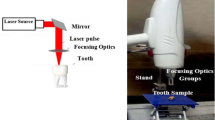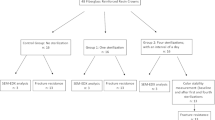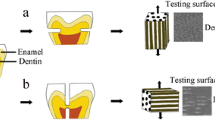Abstract
This study aimed to observe the effects of high temperature on different restorative dental materials by detecting changes in their microstructural and elemental composition. Disk shaped samples (10 mm diameter, 2 mm depth) were prepared from 8 dental materials (compomer, glass carbomer, ormocer, giomer, zinc reinforced glass ionomer (GI), silver-alloy reinforced GI, zirconia reinforced GI, and conventional GI). Scanning electron microscopy/Energy dispersive X-ray spectroscopy (SEM/EDS) was used to characterize sample surface structures and elemental composition. The same samples were also analyzed using X-ray fluorescence (XRF) to determine the trace element content. Each sample was placed in a porcelain furnace and exposed to 900 °C for 30 min. Observations of macroscopic changes in samples after exposure high temperature were recorded. The microstructural changes in sample surfaces after incineration were detected by SEM. The elemental compositions obtained before and after the incineration were compared after repeating the XRF and EDS analyses. Dental materials demonstrated specific macroscopic changes and microstructural deteriorations detected by SEM images after exposure to high temperature. While several changes occurred in the elemental content of materials in terms of amount, the original elemental composition was preserved. The ability to distinguish dental materials by elemental analyses has had an important impact on the identification process.




Similar content being viewed by others
References
Sandholzer M. Influence of heating regimes on dimensional and colorimetric changes of teeth. In: Schmidt CW, Symes SA, editors. The analysis of burned human remains. Tokyo: Elsevier; 2015. p. 365–79.
Ubelaker DH. The forensic evaluation of burned skeletal remains: a synthesis. Forensic Sci Int. 2009;183(1–3):1–5.
Muller M, Berytrand MF, Quatrehomme G, Bolla M, Rocca JP. Macroscopic and microscopic aspects of incinerated teeth. J Forensic Odontostomatol. 1998;16(1):1–7.
Bush MA, Miller RG, Prutsman-Pfeiffer J, Bush PJ. Identification through x-ray fluorescence analysis of dental restorative resin materials: a comprehensive study of noncremated, cremated, and processed-cremated individuals. 2007;52(1):157–65.
Thali MJ, Markwalder T, Jackowski C, Sonnenschein M, Dirnhofer R. Dental CT imaging as a screening tool for dental profiling: advantages and limitations. J Forensic Sci. 2006;51(1):113–9.
Carr RF, Barsley RE, Davenport WD. Postmortem examination of incinerated teeth with the scanning electron microscope. J Forensic Sci. 1986;31(1):307–11.
Dostalova T, Eliasova H, Seydlova M, Broucek J, Vavrickova L. The application of CamScan 2 in forensic dentistry. J Forensic Leg Med. 2012;19(7):373–80.
Soon AS, Bush MA, Bush PJ. Complex layered dental restorations: are they recognizable and do they survive extreme conditions? Forensic Sci Int. 2015;254:1–4.
Reesu GV, Augustine J, Urs AB. Forensic considerations when dealing with incinerated human dental remains. J Forensic Leg Med. 2015;29:13–7.
Zimmerli B, Strub M, Jeger F, Stadler O, Lussi A. Composite materials: composition, properties and clinical applications. A literature review Schweiz Monatsschr Zahnmed. 2010;120(11):972–86.
Ilie N, Hickel R. Resin composite restorative materials Aust Dent J. 2011;56(1):59–66.
Naoum S, Ellakwa A, Martin F, Swain M. Fluoride release, recharge and mechanical property stability of various fluoride-containing resin composites. Oper Dent. 2011;36(4):422–32.
Gorseta K, Borzabadi-Farahani A, Moshaverinia A, Glavina D, Lynch E. Effect of different thermo-light polymerization on flexural strength of two glass ionomer cements and a glass carbomer cement. J Prosthet Dent. 2017;118(1):102–7.
Bush MA, Miller RG, Norrlander AL, Bush PJ. Analytical survey of restorative resins by SEM/EDS and XRF: Databases for forensic purposes. J Forensic Sci. 2008;53(2):419–25.
Bush MA, Bush PJ, Miller RG. Detection and classification of composite resins in incinerated teeth for forensic purposes. J Forensic Sci. 2006;51(3):636–42.
Brandão RB, Martin CC, Catirse AB, de Castro E Silva M, Evison MP, Guimarães MA. Heat induced changes to dental resin composites: a reference in forensic investigations? 2007;52(4):913–9.
Schweitzer JS, Trombka JI, Floyd S, Selavka C, Zeosky G, Gahn NT, et al. Portable generator-based XRF instrument for non-destructive analysis at crime scenes. Nucl Inst Methods Phys Res B. 2005;241(1):816–9.
Bush MA, Bush PJ. Dental materials as an aid for victim identification: examination of calcined remains by SEM/EDS. Proc SPIE 7729, Scanning Microsc. 2010. https://doi.org/10.1117/12.853311
Woisetschläger M, Lussi A, Persson A, Jackowski C. Fire victim identification by post-mortem dental CT: Radiologic evaluation of restorative materials after exposure to high temperatures. Eur J Radiol. 2011;80(2):432–40.
Pramod JB, Marya A, Sharma V. Role of forensic odontologist in post mortem person identification. Dent Res J. 2011;9(5):522.
Fereira JL, Fereira AE, Ortega AI. Methods for the analysis of hard dental tissues exposed to high temperatures. Forensic Sci Int. 2008;178(2–3):119–24.
Rattle CN, Bush MA. Fluorescence and structural degradation in composite resins as a function of temperature. J Forensic Sci. 2009;54(2):433–8.
Biancalana RC, Vicente SADF, Alves da Silva RH, Pires‐de‐Souza FDCP. Color stability of dental restorative materials submitted to heat sources, for forensic purposes. J Forensic Sci. 2017;62(2):355–60.
Christensen GJ. Glass ionomer-resin: a maturing concept. J Am Dent Assoc. 1993;124(7):248–9.
Merlati G, Danesino P, Savio C, Fassina G, Osculati A, Menghini P. Observations on dental prostheses and restorations subjected to high temperatures: experimental studies to aid identification processes. J Forensic Odontostomatol. 2002;20(2):17–24.
Robinson FG, Rueggeberg FA, Lockwood PE. Thermal stability of direct dental esthetic restorative materials at elevated temperatures. J Forensic Sci. 1998;43(6):1163–7.
Rossouw RJ, Grobler SR, Phillips VM. The effects of extreme temperatures on composite, compomer and ionomer restorations. J Forensic Odontostomatol. 1999;17(1):1–4.
Bush M, Miller R. The crash of Colgan Air flight 3407: Advanced techniques in victim identification. J Am Dent Assoc. 2011;142(12):1352–6.
Funding
This study was funded by Çanakkale Onsekiz Mart University. The Scientific Research Coordination Unit (Project number: THD-2019–2861).
Author information
Authors and Affiliations
Corresponding author
Additional information
Publisher’s Note
Springer Nature remains neutral with regard to jurisdictional claims in published maps and institutional affiliations.
Rights and permissions
About this article
Cite this article
Çarıkçıoğlu, B., Misilli, T., Deniz, Y. et al. Effects of high temperature on dental restorative materials for forensic purposes. Forensic Sci Med Pathol 17, 78–86 (2021). https://doi.org/10.1007/s12024-020-00345-x
Accepted:
Published:
Issue Date:
DOI: https://doi.org/10.1007/s12024-020-00345-x




